30-mm automatic and 37-mm semi-automatic anti-aircraft installations of the German fleet during the Second World War
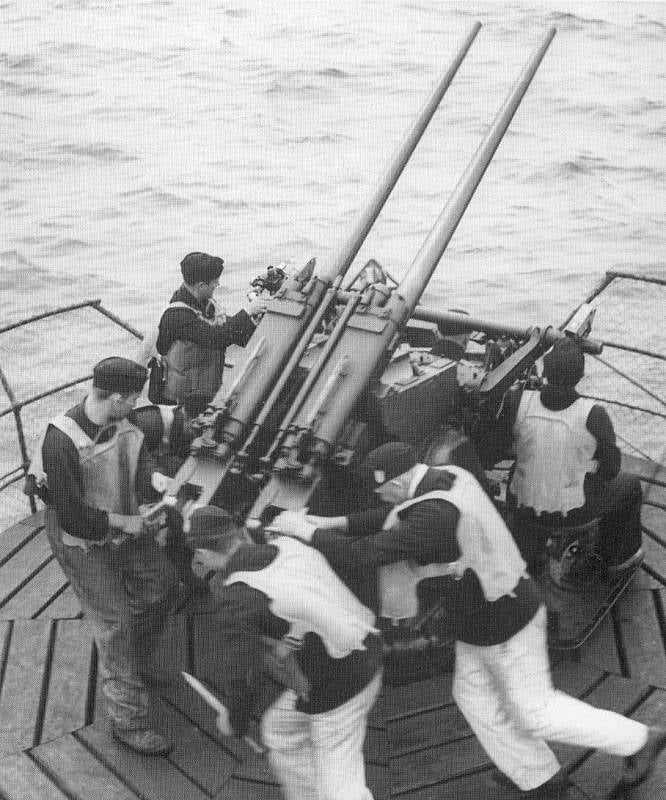
German naval 20-mm anti-aircraft guns have proven to be a very effective means of combating anti-submarine aviation. However, the rate of fire of single-barreled and twin anti-aircraft guns was not always enough to reliably defeat fast-moving targets, and quadruple installations were too heavy and bulky.
In addition, the effective range and destructive effect of 20-mm fragmentation projectiles were very modest, and to reliably disable a heavy flying boat or a four-engine patrol-anti-submarine B-24, it was often necessary to achieve several dozen hits.
In this regard, in the second half of the war, the question arose of equipping German warships with anti-aircraft guns, which, with a high rate of fire, would have an increased range of effective fire and a large destructive effect when hitting a target.
Initially, in this publication, I planned to talk about all German naval anti-aircraft guns with a caliber of more than 20 mm. However, in the course of writing the article, it became clear that in this case the article turns out to be too voluminous, and today we will consider only 30mm automatic and 37mm semi-automatic installations.
30-mm anti-aircraft guns based on the MK.103 aircraft gun
In the second half of the 1930s, the design of 30 mm aircraft guns began in Germany. Weapon of this caliber, first of all, fighter-interceptors designed to counter heavy bombers were to be armed, and 30-mm guns were to be part of the armament of anti-tank attack aircraft and anti-submarine defense aircraft.
In the summer of 1940, Rheinmetall-Borsig AG introduced the 30 mm Maschinenkanone.101 (MK.101) aircraft gun. The operation of the MK.101 automation was based on a short barrel stroke. The mechanical disconnector made it possible to fire both single shots and bursts at a rate of up to 260 rds / min. Food was provided from box magazines with a capacity of 10 rounds or 30-round drums. The mass of the gun with a drum for 30 shots was 185 kg. The length of the gun is 2 mm. Due to the significant mass and dimensions and due to the limited capacity of the store, this aircraft gun was not widely used.
For firing from this gun, a powerful shot measuring 30x184 mm was used. An armor-piercing projectile weighing 455 g, with an initial speed of 760 m/s, when hit at a right angle at a distance of 300 m, could penetrate 32-mm armor. Subsequently, an armor-piercing tracer sub-caliber projectile was introduced into the ammunition load of a 30-mm aircraft gun, which at a distance of 300 m, when hit at an angle of 60º, could penetrate 50-mm armor.
At the beginning of 1942, an improved version appeared, in which many shortcomings were eliminated. The new 30 mm MK.103 cannon weighed 145 kg without ammunition. The mass of a box with a tape for 100 shots is 94 kg. The scheme of functioning of automation is mixed: the extraction of the sleeve, the supply of the next cartridge and the promotion of the tape occurred due to the short rollback of the barrel, and the removal of powder gases was used to cock the bolt and unlock the bore. The MK.103 gun was fed from a loose metal band 70–125 rounds long. Rate of fire - up to 420 rds / min. The range of a direct shot was 800 meters.

This German 30 mm cannon was perhaps the best among serial classmates. According to the complex of combat characteristics, the MK.103 occupied an intermediate position between the Soviet 23-mm VYa and 37-mm NS-37. At the same time, the MK.103 had a number of features that made it difficult to use it as part of the armament of single-engine fighters. Too strong recoil, which the multi-chamber muzzle brake could not mitigate, and the sharpness of the automation limited the use of 30-mm guns.
Production of the MK.103 was carried out from mid-1942 to February 1945, and a significant number of unclaimed 30-mm guns accumulated in the warehouses of the Luftwaffe, which became the reason for their use in anti-aircraft installations.
In the first phase, sometime in early 1943, Luftwaffe ground personnel began mounting 30 mm cannons on primitive and rather crudely made turrets designed to reinforce the air defense of field airfields.
The most effective when firing at air targets were: 330 g high-explosive projectile 3 cm M.-Gesch. o. Zerl., containing 80 g of TNT, and 320 g of high-explosive tracer 3 cm M.-Gesch. L'spur o. Zerl., equipped with 71 g of phlegmatized RDX mixed with aluminum powder. For the manufacture of particularly powerful 30-mm projectiles with a high explosive filling ratio, the technology of "deep drawing" was used, followed by hardening of the steel case with high-frequency currents.
The damaging effect of hitting one high-explosive 30 mm projectile was comparable to hitting three or four 20 mm fragmentation tracer projectiles fired from the 2,0 cm FlaK 38 mount.
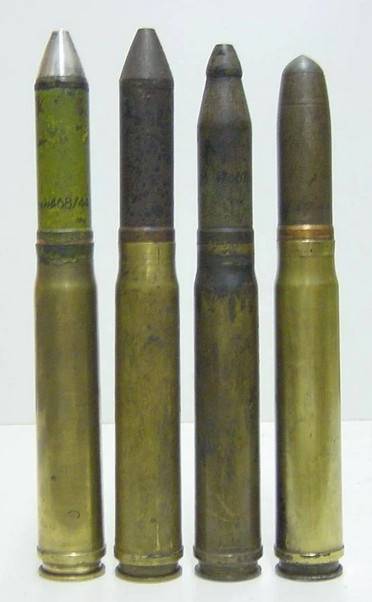
For comparison: the Soviet 37-mm fragmentation tracer UOR-167 weighing 0,732 g, which was part of the 61-K anti-aircraft gun ammunition, contained 37 g of TNT.
In the middle of 1943, the designers of Waffenfabrik Mauser AG created the 30 cm Flak 20/38 installation by imposing a 3,0 mm aircraft gun on a 103 mm Flak 38 anti-aircraft gun machine. Although this installation was in many ways a forced wartime improvisation, on the whole it turned out to be very successful.
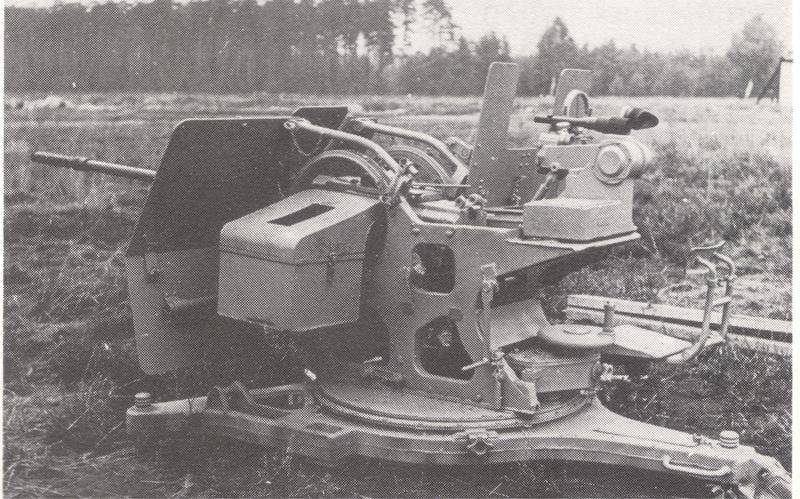
An increase in the caliber of the artillery unit led to an increase in weight by about 30%. The mass of 3,0 cm Flak 103/38 in the transport position was 879 kg, after separation of the wheels - 619 kg. Due to the use of belt feed and a box for 40 shells, the combat rate of fire increased significantly. The heavier 30 mm projectile lost its energy more slowly, while the maximum slant range against air targets was 5 m, and the altitude reach was 700 m. 4 increased by about 700 times.
At the end of 1944, using the MK.103 guns, the 3,0 cm Flakvierling 103/38 was created. Externally, the 30 mm quad mount differed from the 20 mm 2,0 cm Flakvierling 38 by longer and thicker barrels, equipped with a multi-chamber muzzle brake.
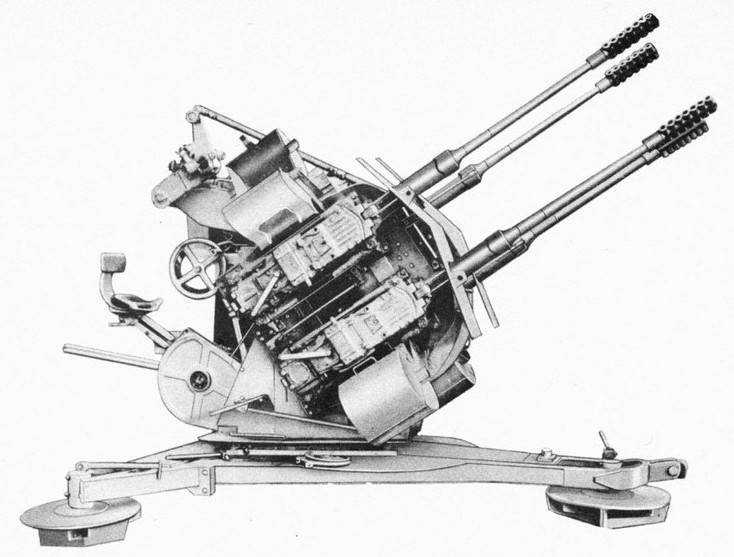
Compared to the 20 mm quad mount, the weight of the 30 mm mount has increased by about 300 kg. The increase in weight was more than offset by increased combat performance. In 6 seconds, the quad installation could fire 160 shells in a continuous burst, with a total mass of 72 kg. Such a “broom” made of steel and fire could, in a matter of moments, “disassemble” into small fragments any well-protected combat aircraft of the Second World War era.
Single-barreled and quadruple German 30-mm anti-aircraft guns based on the MK.103 aircraft gun had high combat characteristics, but, fortunately for the combat aviation of the Red Army and the allies, they were not released much, and they were mainly used by ground units. In addition to the small number, the use in navy 30-mm single-barreled installations, created in accordance with the standards of the Wehrmacht, were hindered by the large weight and dimensions of the machines equipped with mechanical means of aiming, at a time when bollard anti-aircraft installations were mainly mounted on ships.
Nevertheless, in the second half of the war, the Kriegsmarine command made an attempt to strengthen the air defense of the fleet through the introduction of 30-mm anti-aircraft guns.
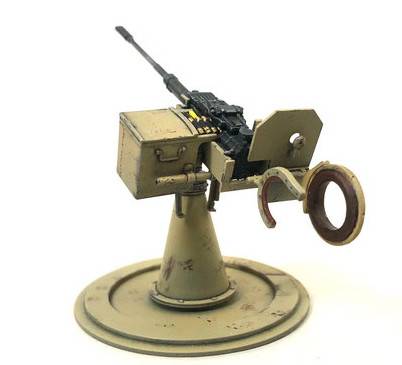
Several dozen 30-mm pedestal installations pushed the 20-mm anti-aircraft guns on torpedo boats and submarines. However, apparently, the 30 mm MK.103 aircraft guns turned out to be not the best option for the fleet, in terms of reliability they were significantly inferior to the well-mastered 20 cm FlaK C / 2 38 mm anti-aircraft guns. The planned re-equipment from 20-mm machine guns to 30-mm MK.103 guns was only partially carried out. A twin 30-mm installation was never developed; instead, the new Schnellbots received two single-gun installations with MK.103 or old-type guns.
After the decision was made to radically strengthen the anti-aircraft armament of German type VII-C submarines, the U-Flak project considered equipping them with quadruple 30-mm 3,0 cm Flakvierling 103/38 mounts, modified in accordance with maritime requirements. But by that time, German submariners already had information that MK.103 aircraft guns give mass failures after swimming in salt water.
30 mm anti-aircraft guns based on the 30 mm MK.303 aircraft gun
The leadership of the German fleet understood that the air defense of the near zone on many combat units needed to be strengthened. First of all, this concerned relatively small patrol and anti-submarine ships, minesweepers, boats and submarines, on which there was not much space to increase the firepower of anti-aircraft weapons by placing numerous artillery mounts of various calibers.
It was very tempting to create a relatively light and compact "intermediate" 30-mm anti-aircraft gun, which would correspond to 20-mm machine guns in terms of rate of fire, and could be compared with 37-mm anti-aircraft guns in terms of effective firing range. In addition to increasing the rate of fire while maintaining the firing range of the 37 mm gun, the new 30 mm anti-aircraft gun had to be relatively light, compact and reliable.
As a basis for the new naval anti-aircraft installation, it was decided to use the 30-mm MK.303 gun, developed by Krieghoff waffenfabrik. This 30mm cannon, billed as "the most powerful and fastest firing", was a scaled version of the aircraft's 20mm MG.301. Automation MK.303 combined a combination of a short recoil of the barrel, the course of which unlocked the bolt, and a gas outlet that reloaded the weapon.
The gun weighing 177 kg and 2,94 m long used powerful 30 mm shots with a 210 mm sleeve length. A projectile weighing 330 g was accelerated to an initial velocity of more than 1 m/s. The rate of fire reached 000 rds / min.
The creation of an anti-aircraft gun based on the 30-mm MK.303 aircraft gun at the end of 1943 was entrusted to Waffenwerke Brünn (as the Czech Zbrojovka Brno was called during the years of occupation).
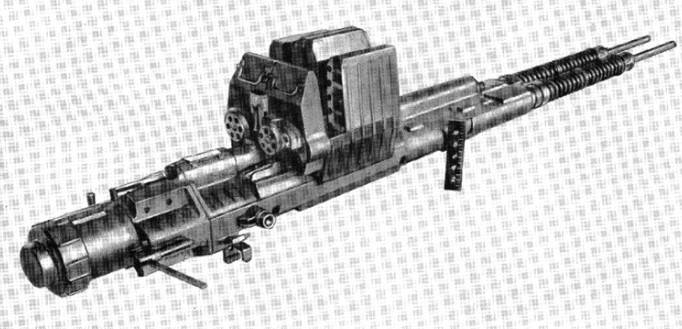
Czech specialists have made significant changes to the design of the artillery unit. It was decided to increase the practical rate of fire of the anti-aircraft installation through the use of twin 30-mm artillery guns.
To increase reliability, the tape feed was abandoned and magazines for 10 or 15 shots were used. With a total rate of fire of 900 rds / min, the combat rate of fire did not exceed 150 rds / min. The length of the gun became longer and amounted, together with the muzzle brake, to 3,145 m with a barrel length of 2,2 m, and the weight increased to 185 kg. The total weight of the anti-aircraft installation was approximately 1 kg. Circular shelling was provided, vertical aiming angles: from -600 ° to + 10 °. Calculation - 85 people.
To ensure the required barrel life and reduce shock loads, the automation reduced the weight of the powder charge, after which the initial speed was 910 m / s. The effective range of firing at aircraft reached 2 m. For 500-mm naval installations 20 cm FlaK C / 2 and 30 cm FlaK C / 2, this figure did not exceed 38 m when firing at fast-moving air targets.
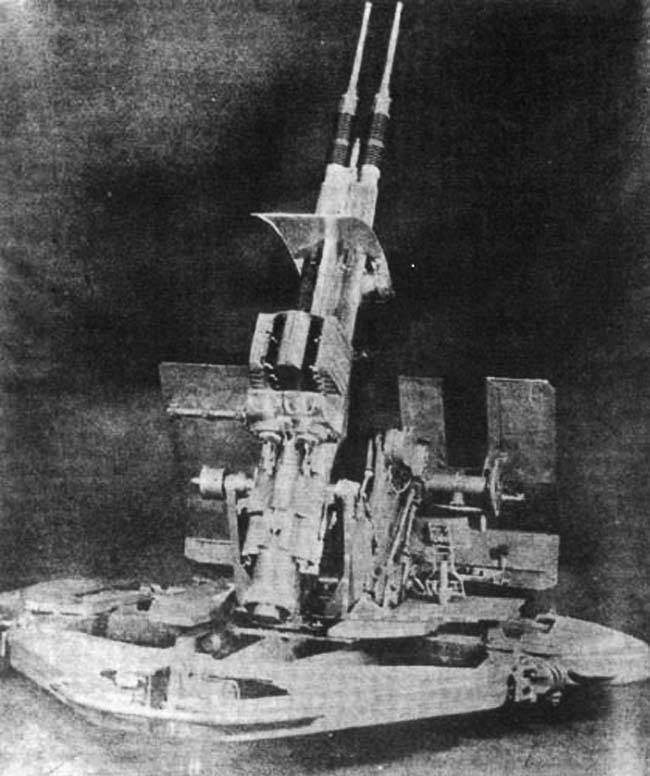
The naval 30 mm twin anti-aircraft gun, which was launched in Brno, received the designation 3,0 cm Flakzwilling MK.303 (Br), the name 3 cm Flak M44 was also sometimes used.
Foreign sources claim that by the end of 1944, 32 copies of the 3,0 cm Flakzwilling MK.303 (Br) were produced at the Brno plant, and during the first four months of 1945 another 190 copies.
Apparently, the 3,0 cm Flakzwilling MK.303 (Br) anti-aircraft guns, designed for warships, were mounted on decks to a very limited extent and were mainly used at coastal facilities. In any case, it was not possible to find photographs confirming the actual use of these 30-mm machine guns on Kriegsmarine ships.
There is information about plans to equip type XXI submarines with 30-mm twin anti-aircraft guns. Anti-aircraft installations were to be placed in two towers with light anti-fragmentation armor, which, when submerged, were automatically retracted inside the wheelhouse. The towers could be controlled directly from inside the pressure hull. However, the matter did not come to the mass implementation of these plans, and an experimental tower installation was tested on one boat.
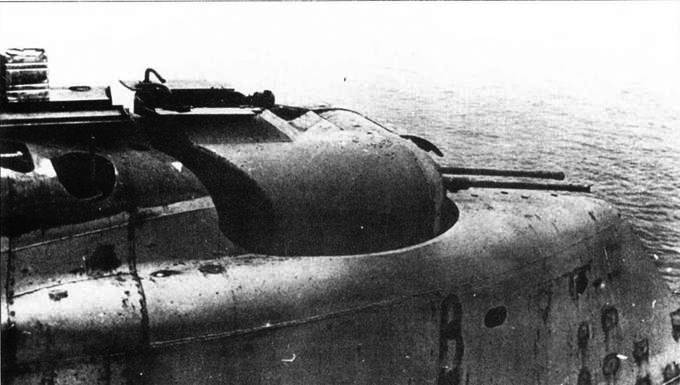
The English-language publications say that the control of the tower was carried out using an electro-hydraulic drive. In the roof of the tower there were special flaps, when opened, the gunner could monitor the air situation and aim the guns at the target. Anti-aircraft fire could be conducted in a semi-submerged state, when only the cabin of the boat towered above the water.
However, taking into account all the circumstances, there was not much point in retracting turret installations inside the hull. Although they protected the crew from bullets and shrapnel, the electro-hydraulic actuators were very complex and not very reliable in prolonged contact with salt water. Heavy towers made the center of gravity of the boat higher, which negatively affected stability. In terms of firing efficiency, tower installations had no advantages over anti-aircraft systems installed on conventional machines. In most cases, the towers were dead weight, as you know, the best guarantee of the invulnerability of a submarine is its stealth.
Although this is beyond the scope of a review dedicated to the anti-aircraft artillery of the German fleet, it would be appropriate to briefly talk about the post-war use of the 30 mm MK.303 aircraft gun.
In the early 1950s, on the basis of the 3,0 cm Flakzwilling MK.303 (Br) naval anti-aircraft gun, a towed 30-mm ZK.453 anti-aircraft gun mod. 1953, which until the mid-1990s was in service in Czechoslovakia and was actively exported.
As for the results of the combat use of single-barreled, twin and quadruple 30-mm anti-aircraft guns, they appeared too late. Although these installations had no analogues in other countries in terms of firepower and firing range and posed a serious danger to aircraft operating at low altitudes, small ships and boats, 30-mm machine guns were used very limitedly in the German fleet.
The rapid offensive of the Red Army did not allow for the mass production of 30-mm rapid-fire anti-aircraft guns that could seriously strengthen the German ship's air defense. In total, about 700 30-mm single-barrel, twin and quad installations were assembled at German and Czech enterprises, which were mainly used on land.
Germany's limited resources, the incessant bombing of defense plants and the successes of the Red Army did not allow the release of the number of 30-mm anti-aircraft guns in volumes that could have a significant impact on the course of hostilities.
37 mm semi-automatic gun 3,7 cm SK C/30
In the late 1920s, the Rheinmetall Borsig AG concern began developing small-caliber naval rapid-fire guns capable of solving air defense tasks and fighting high-speed torpedo boats. After the creation of a number of prototypes, the 37-mm universal rapid-fire gun 3,7 cm SK C / 30 entered service. The letters "SK" in the marking of the gun meant Schiffskanone (German ship's gun), and "C" - Construktionsjahr (German year of creation) with the last two digits of the year separated by a fraction.
The actual adoption of the naval 37-mm guns occurred in the mid-1930s, after the Nazis came to power and refused to comply with the terms of the Versailles Treaty. Thus, the 3,7 cm SK C/30 became the first 37 mm anti-aircraft gun to enter service with the German Navy after the end of the First World War.
In the initial period of World War II, 37-mm single and twin semi-automatic SK C / 30 were the main guns of this caliber in the Kriegsmarine. They armed all types of warships and auxiliary vessels, as well as boats and submarines.
Conceptually, the German 37-mm universal artillery mount was close to the Soviet 45-mm semi-automatic universal gun 21-K, but had better ballistics and a higher rate of fire. Production of the 3,7 cm SK C/30 ended in 1942, with a total of about 1 single and twin guns produced.
For this artillery system, a very powerful unitary shot for this caliber was created with a sleeve length of 381 mm. The total length of a unitary shot is 516,5 mm. In a barrel length of 2 mm, an armor-piercing high-explosive tracer 960 cm Pzgr Patr L'spur Zerl weighing 3,7 g accelerated to 745 m/s. Also, the ammunition included shots with fragmentation tracer and fragmentation-incendiary-tracer projectiles.
Such high ballistic characteristics made it possible to significantly surpass all other mass-produced 37-mm guns in terms of effective firing range. According to German data, at a range of 2 m, the 000 cm SK C / 3,7 was twice as accurate as the towed 30 cm Flak 3,7 anti-aircraft gun. To reduce barrel wear, shells with ceramic-metal leading belts were adopted.
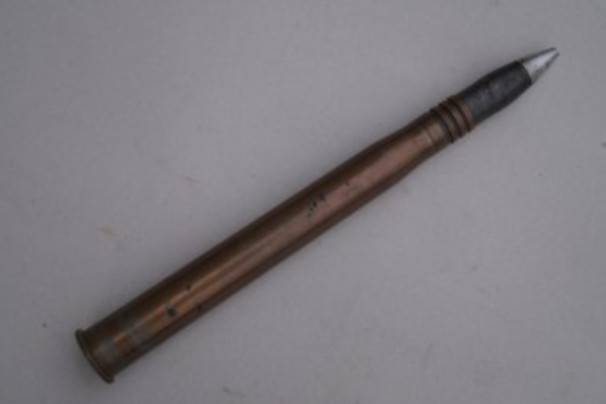
The 37x380R shot was not interchangeable with other German 37 mm anti-tank, anti-aircraft and aircraft guns.
Auxiliary ships of small displacement, boats and submarines were armed with single 37-mm Einh.LC / 34 artillery mounts (Einheitslafette C / 34 - single-gun carriage model 34) with vertical aiming angles: -10 ... + 80 °. Guiding the gun horizontally was carried out due to its free rotation in a horizontal plane using a shoulder rest.
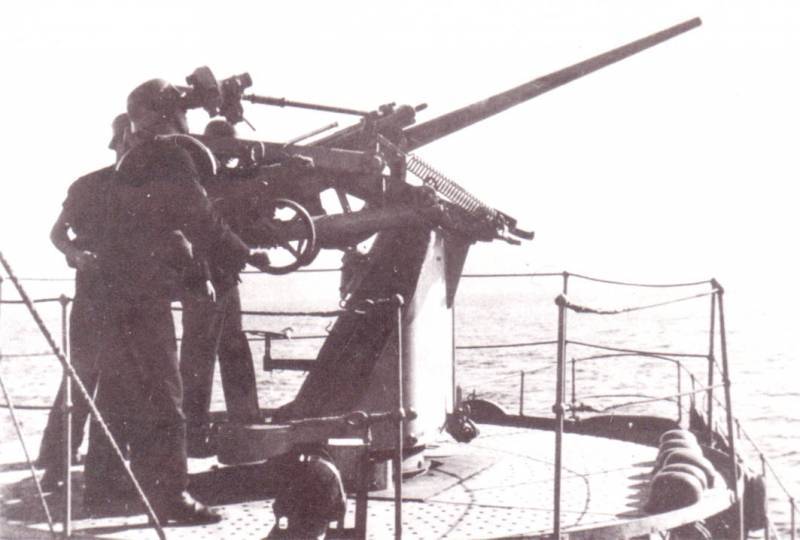
For vertical aiming there was a gear lifting mechanism. The guns were equipped with a hydraulic recoil mechanism and a spring knurler. Since 1942, an armored shield has been used to protect the crew from bullets and shrapnel.
In 1939, a single-barreled 37-mm universal artillery system Ubts.LC / 39 with a 3,7 cm SK C / 30U cannon, designed for arming submarines, was adopted. The mass of this installation was reduced to 1 kg, and the maximum vertical guidance angle was increased to 400 °. The guns designed for submarines used parts made of corrosion-resistant steel.
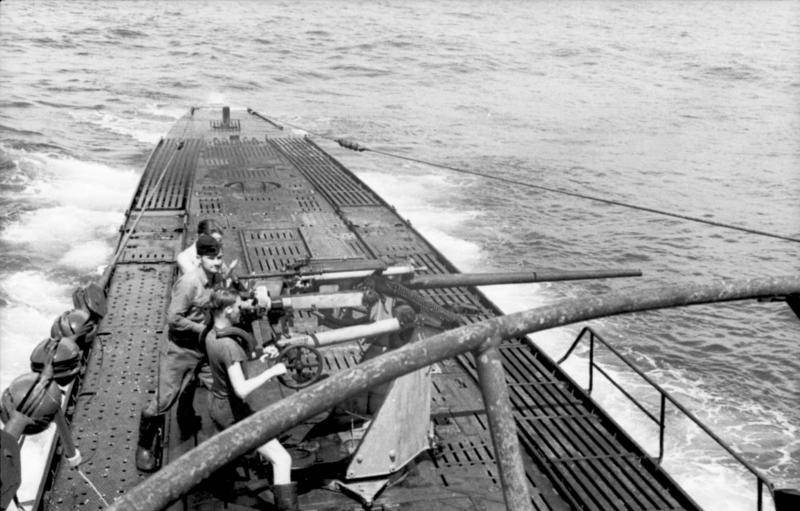
Although the combat rate of fire of the semi-automatic gun did not exceed 30 rds / min, it was more reliable and compact than the 37-mm anti-aircraft guns used on land, and could be brought into combat position faster.
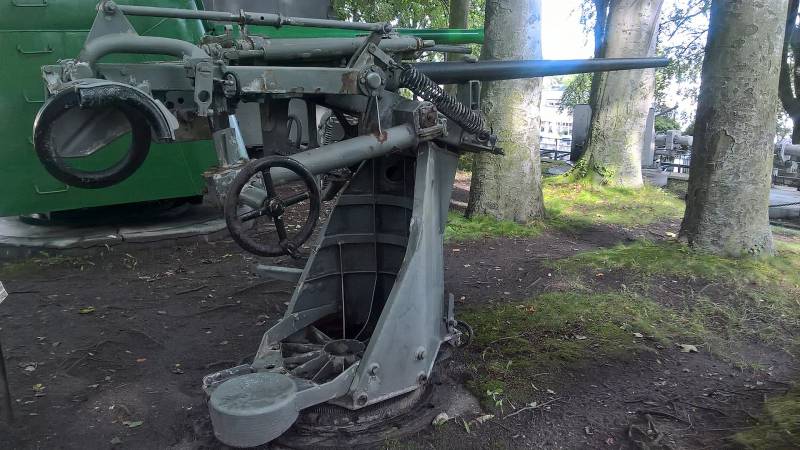
The 3,7 cm SK C/30 twin anti-aircraft gun combined the most advanced design ideas with frankly archaic technical solutions. In the mid-1930s, the Germans became pioneers by installing a 37-mm marine semi-automatic “spark” on a platform stabilized in three planes.
The twin stabilized anti-aircraft gun had the designation Dopp.LC / 30 (German: Doppellafette C / 30 - a two-gun carriage of the 1930 model of the year). With a total mass of 3 kg, almost 670% of the weight of the installation (20 kg) was the weight of the stabilization power drives, which could compensate for the tilt from the side and pitching of the ship within ± 630 °. Vertical guidance angles: from -19,5 ° to + 9 °, and in the horizontal plane circular fire was provided.
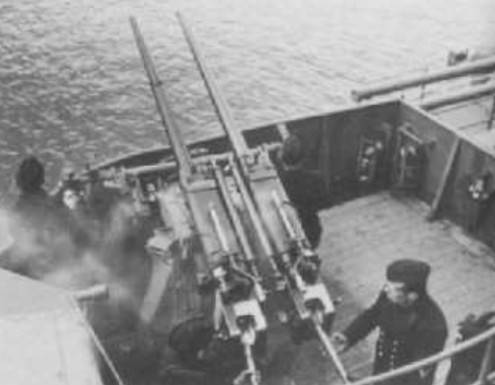
The paired 37-mm anti-aircraft guns initially did not have any armor protection, not counting the 14-20-mm steel parapets on cruisers and battleships. However, since 1942, these installations have been equipped with shields made of 8 mm armor steel.
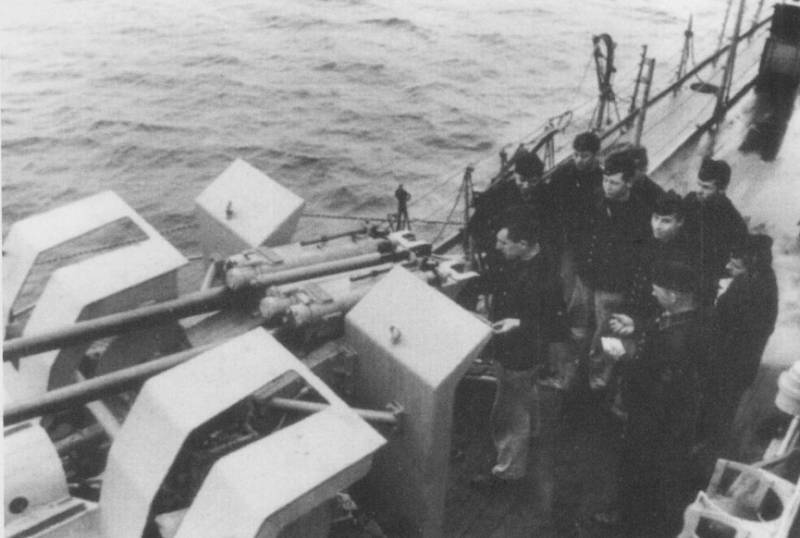
In terms of accuracy of fire, the 37-mm German naval "spark" surpassed all existing 37-40-mm ship and land anti-aircraft guns at that time, but its rate of fire was limited by a semi-automatic vertically sliding wedge bolt with manual loading of each shot.
The practical rate of fire of a twin anti-aircraft mount directly depended on the level of training of the crew and in most cases did not exceed 60 rds / min, which was almost two times less than that of a land-based single-barrel anti-aircraft gun 3,7 cm Flak 18.
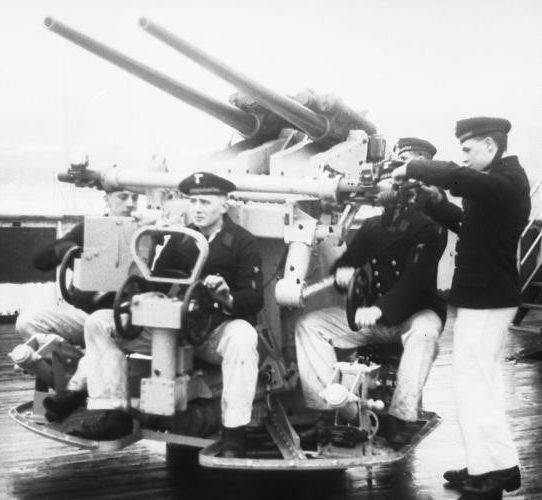
Despite this, twin 37-mm installations were widely used in the German Navy and were used on most of the German warships of the destroyer class and above. Destroyers carried two such universal artillery systems, light cruisers had four twins, heavy cruisers had six, and battleships had eight twins. Very often they were put on large mobilized ships of the merchant fleet, which were involved in military transportation.
In the course of hostilities, it turned out that with strong excitement and splashing, the stabilization system often fails due to sea water entering electrical circuits. In addition, with intensive maneuvering of destroyers that were attacked by enemy aircraft, weak electric drives did not always have time to compensate for angular accelerations. Numerous failures in the operation of the stabilization system and a low combat rate of fire became the reasons that in 1943 the 3,7 cm SK C / 30 semi-automatic guns on the decks of warships began to be replaced by 37-mm anti-aircraft guns.
Although single and twin semi-automatic 1945 mm universal guns were considered obsolete by 37, their operation continued until the end of hostilities.
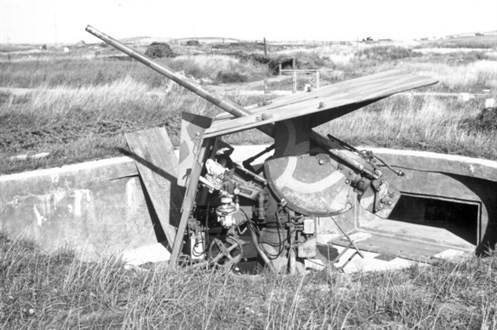
Starting in 1943, a significant number of 37-mm single-barreled and twin installations were transferred to coastal air defense units and placed in the fortifications of the Atlantic Wall.
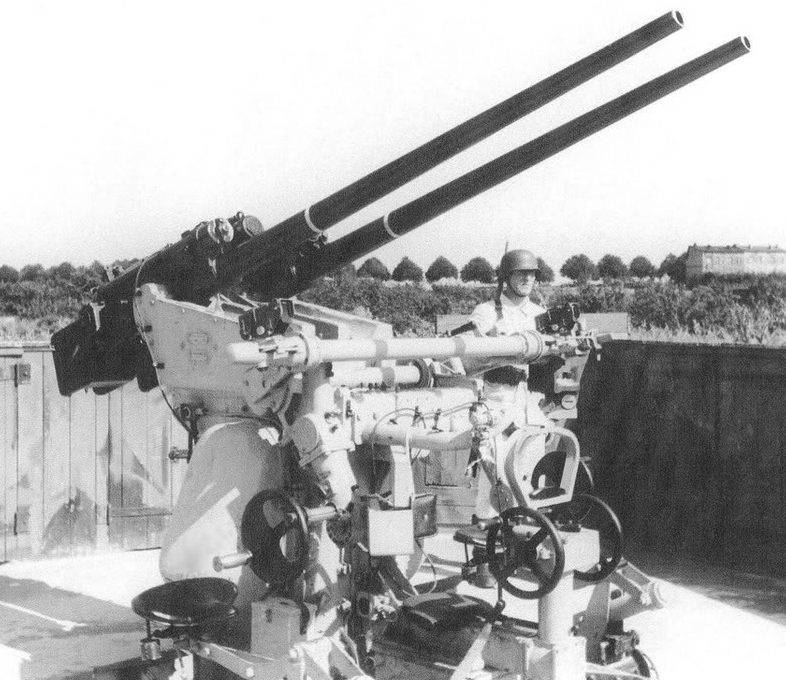
After the dismantling of the stabilization system, which was unnecessary on the coast, 37-mm twin anti-aircraft guns strengthened the air defense of naval bases and ports. Due to the lack of wheeled gun carriages, rather heavy Dopp.LC/30 "sparks" were placed in stationary positions and railway anti-aircraft batteries.
To be continued ...
Articles from this series:
Anti-aircraft machine gun installations of the German fleet during the Second World War
20-mm anti-aircraft artillery installations of the German fleet during the Second World War
Information